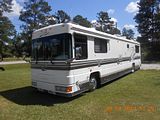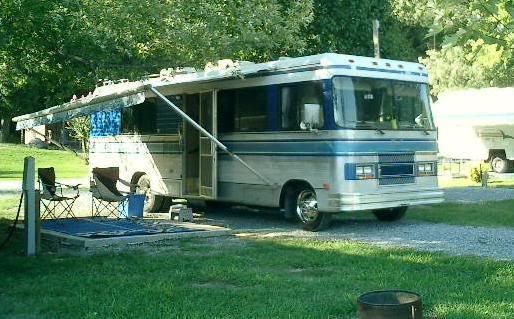Go to...  | Start A New Topic  | Search  | Notify  | Tools  | Reply To This Topic  |  |
"Host" of Barthmobile.com 1/19 1/19 |
This is a takeoff from Ed's post on adding fresh air intake.
| ||||||||||||||
| |||||||||||||||
Moved Reply: Ya know i have had this thought for years and wondered why nobody has tried it. A cold air intake is only inducting outside air at ambient temp right? So if you happen to be running your a/c anyway, (yes i know it is a power drain ) why not run a duct from it into your intake and put some substantially cooler air into your engine? It seems like it should make a lot more difference. Would it? I figure Bill H, Old Roy, and Gary Carter, among others, ought to have some good thoughts on this. | ||||
|
| The Old Man and No Barth |
Moved Reply: Someone else needs to check my math on this, but I just calculated that a 454 consumes 227 cu.in of air per revolution, meaning it sucks in about 33 cu ft per minute, @ 3000 rpm. Air conditioners are rated in btus, & I don't how much volume they produce, but in any event, you'd be taking air from the interior of the coach that would have to be replaced by outside air, thus defeating the objective of cooling the interior air by passing it through the a/c heat exchanger. We all know it takes awhile to cool down the interior once we turn the a/c on. Providing the engine intake with its own a/c to cool the intake air would be another matter, but someone with a better knowledge of physics than I would have to calculate if the performance gained would justify the cost of the added machinery, & the energy expended to accomplish it. I have a notion you'd lose more than you gained. It's too early on a Sunday morning for me to mess with it any more. | |||
|
 8/09 8/09 |
Moved Reply:
Wow, and I thought today was only Saturday! | |||
|
| The Old Man and No Barth |
Moved Reply: Barthers clocks run faster. | |||
|
| First Month Member |
Moved Reply: Five cent version: On a gasser, with Ed's proposed setup, for every ten degrees F the cabin air is below the outside air, horsepower goes up 1 percent. Five dollar version: Cooling the intake charge has been around since at least the 20s. It is most effective when there is a great differential between the outside air and the intake manifold. Supercharged engines raise the intake temperature because of the compressing that takes place, and intercoolers, using an air or water heat exchanger do the job. On a normally aspirated engine, the temp differentials are less dramatic, so the benefit is less dramatic, as well. The general rule of thumb is that every 10 degree F that you drop yields a 1% increase in horsepower at full throttle. I run cold air on several of my vehicles because it is a good idea. The only dramatic improvement I have seen is on my jet boat, which operates on the Colorado river where land temperatures can get up to the high 120s, and the engine is fully enclosed. The boat has a digital tach and I use a GPS for speed. Additionally, a water jet is essentially a dyno, and water is always level, so it is not very difficult to get repeatable and easily measured results. My boat engine has some dyno time, but we didn't do intake temp comparisons. But if my digital tach and Berkeley's RPM vs HP chart are accurate, the rule of thumb is very close. A previous jet boat, which had a little open doghouse for the carb to stick up from the engine cover, benefited from the intake air being sealed from the hot engine box temperatures. Turning the doghouse around for ram air showed no gain, verifying the literature on that subject. There are too many variables for me to report any accurate results on my road vehicles. A fixed-pitch prop carbureted airplane is also another good indicator of the difference between hot and cold air intake. Carburetor heat drops RPM every time (unless it is melting ice). Now, to Ed's conditioned air intake, I would not want the noise and shut-off fumes in my interior, but colder air has to be good. Making it quieter without losses would be a challenge. Drag racers sometimes dump ice cubes on the intake manifold to lower intake temp. Perhaps running conditioned air directly into the air cleaner would be more effective. We could apply the ten degrees/one percent rule and subtract the power taken by the compressor and blower. The easy answer is, if the racers don't do it, maybe it isn't efficient. The ice they use doesn't take any power. Any gasser Barthers who do not have smog inspection can block off their heat risers, either at the valve, or better, at the intake manifold or heads. A thin piece of stainless steel blocking the hole in the intake gasket does the job. Joe Mondello used to sell cast iron plugs for the heat riser passages in Olds heads. They worked a little better, as the passage opening no longer interfered with intake flow. Quadrajets are happier without the added heat from heat risers, too. But, you have to go to an electric choke, and cold winter warm-up takes a little longer. Also, intake heating can be reduced by an oil splash shield in the valley keeping hot oil off the manifold. Anyone who has torn down an old engine can remember the coke that forms on a heat riser passage, indicating the high temperatures there. Or, maybe a bunch of Peltier devices epoxied to the bottom of the plenum of an insulated and heat-shielded aluminum intake manifold. Again, we would have to measure temp drop gains vs power loss for the extra generator load. Or use the solar-charged coach batteries to power the Peltiers and make it a hybrid. . 84 30T PeeThirty-Something, 502 powered | |||
|
| The Old Man and No Barth |
Moved Reply: See how much difference three hours time, & possession of a still-functioning brain makes? | |||
|
 6/12 6/12Formally known as "Humbojb"  |
Moved Reply: Geez, you guys are good! Jim
| ||||||||||||
|
Moved Reply: Bill, what i had sort of envisioned was a duct from your ac that could be opened or closed as needed that went directly into your air cleaner. I figured that if you were running the ac anyway that you would not notice a little less cold air in the cabin unless it was really hot out.....moot point for us as the ac in the jeep hasn't worked for 10 years, we just run with the windows down, (95 degrees yesterday) and have only run the bus with the ac on a couple of times as the genny is propane and the tanks are small and will run out in a couple of days if we use it. Besides i am not a big fan of ac anyway.....get too used to it and it always seems hot outside even if it is only in the low 70's. | ||||
|
| First Month Member |
Moved Reply: With a slightly clearer mind, today, it has also occurred to me that an air conditioner compressor puts a heat load on the cooling system. The time of greatest need for more power is also the time of greatest need for good cooling, i.e. climbing a steep hill. Many steep grades in CA have signs at the approach cautioning drivers to turn off the air conditioning. Of course, none of this would apply if we were talking about running a duct from the roof air to the engine intake. Susan has already told me she ain't allowin' no stinkin' duct in her living room. I wore out her tolerance on that by running a duct to the upper bedroom of a single-AC fifth wheel. . 84 30T PeeThirty-Something, 502 powered | |||
|
Captain Doom |
Moved Reply: Gotta remember "TINSTAAFL" - There Is No Such Thing As A Free Lunch. Without boring anyone with too much thermodynamics, the efficiency of both external combustion (i.e., steam or gas turbine) and internal combustion engines is measured with repect to absolute zero (0°K, -73°C, -460°F). So if we take intake air from ambient at 100°F and cool it 20°F (and this amount would be VERY optimistic), this increases efficiency by 20/(460+100), or 3%. (This is greatly simplified and theoretical). However, the typical Otto Cycle (gasoline) engine operates at 15-18% efficiency, so we multiply .03x.18 and the resulting 0.5% increase is scarcely worthwhile, when the intake air in the engine compartment is likely well over 150°F, and a simple duct to the ambient 100°F provides, in theory, a 1%+ net with no complexity. Add to that the increased heat passed from the A/C condenser to the radiator, and there's no gain in cooling, either (actually a loss, since the A/C cycle is inefficient also). But the outside duct will provide (very) slightly cooler running with no penalty. Rusty '94 28' Breakaway: MilSpec AMG 6.5L TD 230HP Nelson and Chester, not-spoiled Golden Retrievers Sometimes I think we're alone in the universe, and sometimes I think we're not. In either case the idea is quite staggering. - Arthur C. Clarke It was a woman who drove me to drink, and I've been searching thirty years to find her and thank her - W. C. Fields | |||
|
 |
Moved Reply: Or you could just move to the arctic circle and run a duct to the front grill. Nick | |||
|
| First Month Member |
Moved Reply:
While I do indeed embrace that concept, superchargers and turbochargers use engine power to make more engine power. We could even look at the turbofan jet engine the same way, although they are morphing into ducted-fan turboprops, with their high bypass ratios. There is even one company out there marketing an electric blower that helps get the exhaust out, thereby increasing power. This is using electric power from the crankshaft-driven alternator to spin the blower to make more power. I would like to see some dyno or hill climb tests on that one. And the Wright PRT.......Oh, my goodness! Yah, I know the turbocharger and the PRT use another thermodynamic cycle, at least partially, but both benefit from the pumping of the pistons. See, what you started, Ed? . 84 30T PeeThirty-Something, 502 powered | |||
|
Moved Reply: | ||||
|
Captain Doom |
Moved Reply:
While they do increase power, in terms of efficiency, the mechanical superchargers, no; turbo superchargers, yes. Mechanical superchargers (a la' the 140HP 68-69 Corvair and some Buick Grand Nationals), added horsepower, but sapped some of it driving the blower. Turbo superchargers provide free boost (almost, because the exhaust restrictions do sap a bit of energy by increasing back pressure.) Rusty '94 28' Breakaway: MilSpec AMG 6.5L TD 230HP Nelson and Chester, not-spoiled Golden Retrievers Sometimes I think we're alone in the universe, and sometimes I think we're not. In either case the idea is quite staggering. - Arthur C. Clarke It was a woman who drove me to drink, and I've been searching thirty years to find her and thank her - W. C. Fields | |||
|
| Powered by Social Strata | Page 1 2 3 |
| Please Wait. Your request is being processed... |
|
This website is dedicated to the Barth Custom Coach, their owners and those who admire this American made, quality crafted, motor coach.
We are committed to the history, preservation and restoration of the Barth Custom Coach.
We are committed to the history, preservation and restoration of the Barth Custom Coach.






